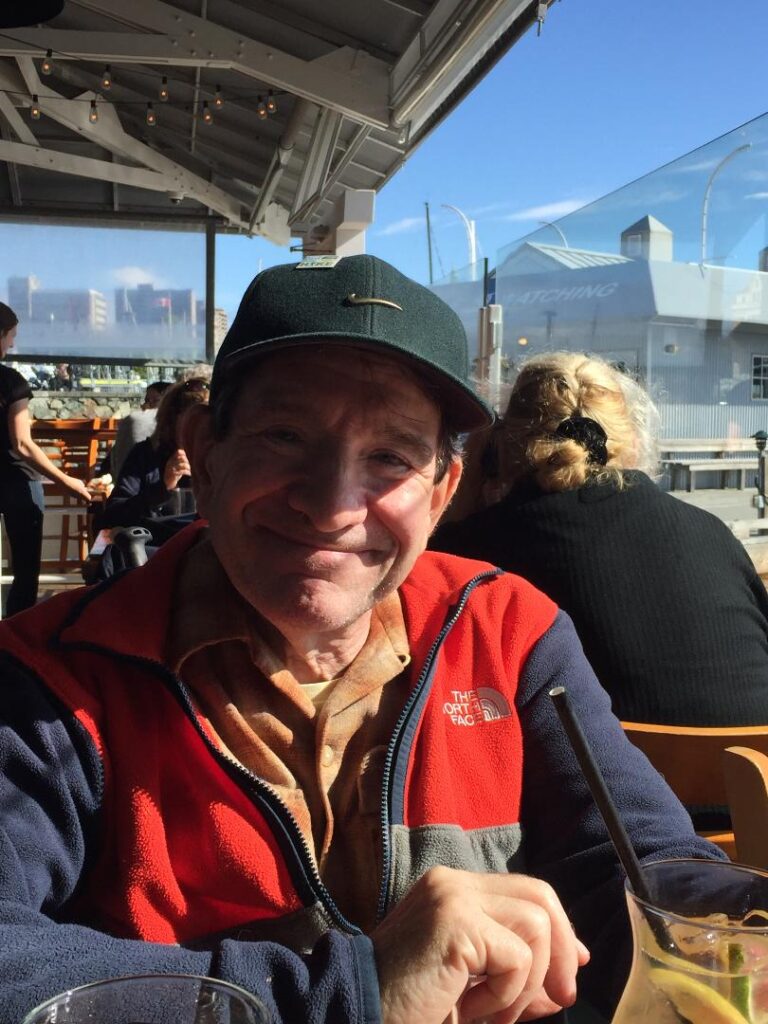by David Margolin
At Monolingual International Airport, Terminal B, everything appeared to be in order at The Tower of Babel Café. There was a cashier, a cook, and a customer, but there was a crucial limiting factor: they shared no language in common.
New customers attempted to place their order verbally, only to be thwarted by The Cashier’s stare, a combination of bewilderment and recalcitrance that froze further attempts at conversation.
Pointing at the desired item on the menu was an obvious strategy, but the menu choices were displayed on a digital monitor incredibly briefly (a hair above subliminal), before being replaced by a series of commercials, news bites, and interviews with local celebrities and former customers of the cafe. Also, the monitor was out of reach for everyone except for customers who were exceptionally long-armed, and athletic enough to leap over the counter and point at the same time.
Even if the target item could be pointed at, the cutesy idiosyncratic names (e.g., “Airiel,” “Standby,” and “Landing Gear”) offered very limited insight into the contents of the offerings.
The most successful–and by far the most entertaining–strategy for ordering was creative pantomiming. One patron accurately drew an outline of Italy in the air to communicate his choice of the “Godfather” Italian sub sandwich. Another patron offered an impressive performance of a fish being caught and laid out on a sandwich in hopes of landing the “Mariner’s Delight.” The hot dog “Big Frank” was not ordered frequently, because few people could think of pantomime options that did not risk a slap in the face.
Although imaginative, and occasionally successful, these strategies were very time consuming. Frequently the line to order snaked out of the confines of the restaurant space and into the main concourse. The congestion was amplified by curious passersby who stopped to watch the would-be diners’ pantomime show. The best performers drew a round of applause and cheers.
Experienced customers knew the unwritten rule to not ask any questions of the beleaguered staff of two. Violating the rule led to awkward exchanges.
Naive Customer asked: “Is the ‘Beefy & Cheesy’ served hot or cold?”
The Cashier stared blankly.
Naive Customer: “The temperature…of the sandwich…the meat and the cheese inside, is it hot or cold?”
The Cashier nodded vaguely in the affirmative.
Finally realizing that words would not suffice, Naive Customer shifted to the pantomiming strategy to discover the temperature of the sandwich. For hot, she simulated a person dying of thirst under an intensely-beating desert sun. For cold, she portrayed a person trapped in a deep freeze experiencing body-racking shaking chills.
Reluctantly hinting at a smile, The Cashier hugged herself and shivered.
Energized by the thrill of victory, Naive Customer activated the laser pointer on her smart phone with lightning speed, just in time to choose “Beefy & Cheesy” as it flashed on the menu monitor for a semi-instant.
There was still a formidable bridge to cross. How was The Cashier going to communicate this order to The Cook? As a cost-saving device, the cafe owners had chosen not to invest in any type of electronic communication between the cashier and the cook. Through a process of trial and error, the two had developed an elaborate communication scheme that relied on a combination of subtle and not so subtle body movements, including shrugs, nods, twitches, and facial expressions.
Between the customer-cashier and the cashier-cook language gaps, it took a minor miracle for a customer to receive the correct order. A hoody was designed with “The Tower of Babel Cafe” logo on the back (an ancient-appearing tower reaching high into the sky, with diners on every floor, and airport activity in the background, including modern traffic control towers), and “I GOT WHAT I ORDERED!” in raised gold lettering on the front. These successful orderers became known as “Brilliant Babblers.” Sales of knock-off versions of the hoodies went viral.
The Cook and The Chef were enjoying the notoriety. Autograph and selfie seekers became increasingly common. People began arriving two hours early for their flights to see the show in Terminal B. The inter-terminal shuttle bus fleet had to be doubled and then tripled as Terminal B became a destination spot, even for travelers departing from other terminals.
The cafe’s notoriety skyrocketed after the reality TV show What’s My Order? began airing. The viewership increased exponentially and within six months it surpassed all of the other reality shows in popularity. There was a spin-off dating show—Brilliant Babblers Make Better Lovers. In addition to their looks and physique, contestants were judged based on their ability to court by pantomime.
A group of cultural anthropologists was assembled from leading academic centers around the world; they got permission from airport security to set up shop in Terminal B. Their team included linguists, transcriptionists, and a camera crew. That crew and the “What’s My Order?” camera crew were constantly elbowing for locations that offered the best camera angle.
The fame was fleeting. Within six months The Cashier left the café to work full time as a subculture social-media influencer. The Cook became a celebrity chef on the local food channel. The café space was converted to rent out sleeping pods. The crowds died down, but the café has not been forgotten.
At the Troll & Roll in Terminal B, some customers insist on pantomiming their orders for the $37.00 four-small-bite lobster roll ($38.00 with a squirt of lemon). This usually involves claw snapping and rolling over at the same time. At the former site of the café, people still come to take selfies and pantomime their favorite menu items. Some leave partially eaten sandwiches in homage.
It is also common to see travelers watching reruns of What’s My Order? and Brilliant Babblers Make Better Lovers on their devices as they wait to board their planes. There is no doubt about what they are watching, as they pantomime along with the contestants, and mouth or whisper, “Airiel,” “Standby,” “Beefy and Cheesey!”

David Margolin lives, works, and writes in Portland, Oregon. During his career as a Neurologist he has done a lot of medical/scientific writing. Now he is enjoying the relative freedom of creative writing. He has published in Friday Flash Fiction, Five Minutes, R U Joking?, Little Old Lady Comedy, Bright Flash Literary Review, Memoir Magazine, and Witcraft.


